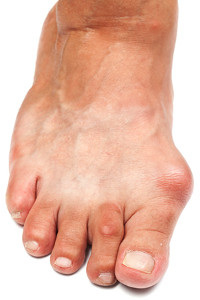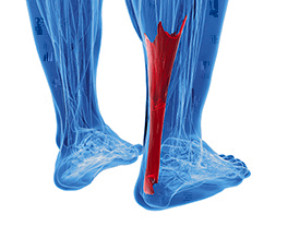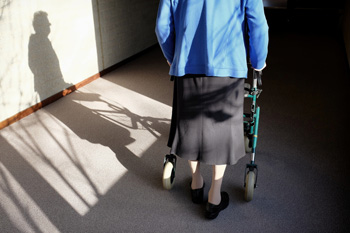Items filtered by date: July 2019
How Do Bunions Develop?
 A large bony bump on the side of the big toe is referred to as a bunion. It can occur as a result of genetic factors, and from shoes that are worn which do not fit correctly. There may be inadequate room for the toes to move freely in, and this may cause the big toe to gravitate to the toe next to it. There are common symptoms that are often associated with bunions, including red and hardened skin over the affected toe, and it may be difficult to move and to wear shoes. Mild relief can be found when larger shoes are worn, and it may be helpful to wear a protective pad on top of the toe. For severe bunions, surgery could be a successful treatment option for permanent removal. If you are afflicted with a bunion, it is suggested that you seek the counsel of a podiatrist who can properly manage this condition.
A large bony bump on the side of the big toe is referred to as a bunion. It can occur as a result of genetic factors, and from shoes that are worn which do not fit correctly. There may be inadequate room for the toes to move freely in, and this may cause the big toe to gravitate to the toe next to it. There are common symptoms that are often associated with bunions, including red and hardened skin over the affected toe, and it may be difficult to move and to wear shoes. Mild relief can be found when larger shoes are worn, and it may be helpful to wear a protective pad on top of the toe. For severe bunions, surgery could be a successful treatment option for permanent removal. If you are afflicted with a bunion, it is suggested that you seek the counsel of a podiatrist who can properly manage this condition.
If you are suffering from bunions, contact Dr. Steven Sheridan of Ankle & Foot Specialty Clinics. Our doctor can provide the care you need to keep you pain-free and on your feet.
What Is a Bunion?
A bunion is formed of swollen tissue or an enlargement of boney growth, usually located at the base joint of the toe that connects to the foot. The swelling occurs due to the bones in the big toe shifting inward, which impacts the other toes of the foot. This causes the area around the base of the big toe to become inflamed and painful.
Why Do Bunions Form?
Genetics – Susceptibility to bunions are often hereditary
Stress on the feet – Poorly fitted and uncomfortable footwear that places stress on feet, such as heels, can worsen existing bunions
How Are Bunions Diagnosed?
Doctors often perform two tests – blood tests and x-rays – when trying to diagnose bunions, especially in the early stages of development. Blood tests help determine if the foot pain is being caused by something else, such as arthritis, while x-rays provide a clear picture of your bone structure to your doctor.
How Are Bunions Treated?
- Refrain from wearing heels or similar shoes that cause discomfort
- Select wider shoes that can provide more comfort and reduce pain
- Anti-inflammatory and pain management drugs
- Orthotics or foot inserts
- Surgery
If you have any questions, please feel free to contact our office located in Sandusky, MI . We offer the newest diagnostic and treatment technologies for all your foot care needs.
How Does Toenail Fungus Enter The Body?
 A toenail fungus is considered to be an infection of the nails. Common symptoms that are often associated with this condition can include noticeable discoloration of the toenails, and they may appear thick. Additionally, many patients see their nails beginning to crack, and this can cause an unsightly appearance. This type of fungus is known to be contagious, and typically lives and thrives in warm and moist environments. These often include public swimming pools and surrounding areas, shower room floors, and locker rooms. The fungus can enter through tiny cracks in the skin, and the toenails can gradually become affected. Patients who are diabetic or have a weakened immune system may be more likely to contract this type of fungus. There are methods that can be implemented which may help to prevent the fungus from entering the body. These include wearing appropriate shoes while in public areas, and avoiding sharing shoes, socks, or nail trimmers. If you have toenail fungus, please consult with a podiatrist who can offer proper treatment options.
A toenail fungus is considered to be an infection of the nails. Common symptoms that are often associated with this condition can include noticeable discoloration of the toenails, and they may appear thick. Additionally, many patients see their nails beginning to crack, and this can cause an unsightly appearance. This type of fungus is known to be contagious, and typically lives and thrives in warm and moist environments. These often include public swimming pools and surrounding areas, shower room floors, and locker rooms. The fungus can enter through tiny cracks in the skin, and the toenails can gradually become affected. Patients who are diabetic or have a weakened immune system may be more likely to contract this type of fungus. There are methods that can be implemented which may help to prevent the fungus from entering the body. These include wearing appropriate shoes while in public areas, and avoiding sharing shoes, socks, or nail trimmers. If you have toenail fungus, please consult with a podiatrist who can offer proper treatment options.
For more information about treatment, contact Dr. Steven Sheridan of Ankle & Foot Specialty Clinics. Our doctor can provide the care you need to keep you pain-free and on your feet.
Toenail Fungus Treatment
Toenail fungus is a condition that affects many people and can be especially hard to get rid of. Fortunately, there are several methods to go about treating and avoiding it.
Antifungals & Deterrence
Oral antifungal medicine has been shown to be effective in many cases. It is important to consult with a podiatrist to determine the proper regiment for you, or potentially explore other options.
Applying foot powder on the feet and shoes helps keep the feet free of moisture and sweat.
Sandals or open toed shoes – Wearing these will allow air movement and help keep feet dry. They also expose your feet to light, which fungus cannot tolerate. Socks with moisture wicking material also help as well.
If you have any questions please feel free to contact our office located in Sandusky, MI . We offer the newest diagnostic tools and technology to treat your foot and ankle needs.
What Is the Purpose of the Achilles Tendon?
 The largest tendon in the body is known as the Achilles tendon. Its function is to connect the heel bone to the calf muscles. Many tendons in the body are not flexible, and it is important to properly stretch this tendon before engaging in a sporting activity. If it should become irritated and inflamed, the result may be an Achilles tendon injury. The symptoms that are often associated with this type of injury can include tenderness, severe pain, discomfort, and the inability to bend the foot downward. If this tendon is not properly stretched, many people could tear their Achilles tendon if they start a new exercise regime, or increase the intensity considerably. There are numerous treatment options for this type of injury. If you feel you have injured your Achilles tendon, it is advised to consult with a podiatrist who can guide you toward the best treatment option.
The largest tendon in the body is known as the Achilles tendon. Its function is to connect the heel bone to the calf muscles. Many tendons in the body are not flexible, and it is important to properly stretch this tendon before engaging in a sporting activity. If it should become irritated and inflamed, the result may be an Achilles tendon injury. The symptoms that are often associated with this type of injury can include tenderness, severe pain, discomfort, and the inability to bend the foot downward. If this tendon is not properly stretched, many people could tear their Achilles tendon if they start a new exercise regime, or increase the intensity considerably. There are numerous treatment options for this type of injury. If you feel you have injured your Achilles tendon, it is advised to consult with a podiatrist who can guide you toward the best treatment option.
Achilles tendon injuries need immediate attention to avoid future complications. If you have any concerns, contact Dr. Steven Sheridan of Ankle & Foot Specialty Clinics. Our doctor can provide the care you need to keep you pain-free and on your feet.
What Is the Achilles Tendon?
The Achilles tendon is a tendon that connects the lower leg muscles and calf to the heel of the foot. It is the strongest tendon in the human body and is essential for making movement possible. Because this tendon is such an integral part of the body, any injuries to it can create immense difficulties and should immediately be presented to a doctor.
What Are the Symptoms of an Achilles Tendon Injury?
There are various types of injuries that can affect the Achilles tendon. The two most common injuries are Achilles tendinitis and ruptures of the tendon.
Achilles Tendinitis Symptoms
- Inflammation
- Dull to severe pain
- Increased blood flow to the tendon
- Thickening of the tendon
Rupture Symptoms
- Extreme pain and swelling in the foot
- Total immobility
Treatment and Prevention
Achilles tendon injuries are diagnosed by a thorough physical evaluation, which can include an MRI. Treatment involves rest, physical therapy, and in some cases, surgery. However, various preventative measures can be taken to avoid these injuries, such as:
- Thorough stretching of the tendon before and after exercise
- Strengthening exercises like calf raises, squats, leg curls, leg extensions, leg raises, lunges, and leg presses
If you have any questions please feel free to contact our office located in Sandusky, MI . We offer the newest diagnostic tools and technology to treat your foot and ankle needs.
Gout Pain Can Be Managed
How Do Cracked Heels Develop?
 Many patients experience dry skin on the heels, and this is often the result of a lack of moisture in the skin on the feet. There are several reasons why this condition may develop. These consist of standing for extended periods of time throughout the day, wearing shoes that have an open back, or from being overweight. Additionally, there may be existing medical conditions that may contribute to the onset of cracked heels, which can include psoriasis, diabetes, or hypothyroidism. Mild relief may be found when the feet are washed and dried daily, followed by using a good moisturizer. If the cracks on the skin become severe, and appear to be deep, it is suggested to consult with a podiatrist who can recommend proper treatment options.
Many patients experience dry skin on the heels, and this is often the result of a lack of moisture in the skin on the feet. There are several reasons why this condition may develop. These consist of standing for extended periods of time throughout the day, wearing shoes that have an open back, or from being overweight. Additionally, there may be existing medical conditions that may contribute to the onset of cracked heels, which can include psoriasis, diabetes, or hypothyroidism. Mild relief may be found when the feet are washed and dried daily, followed by using a good moisturizer. If the cracks on the skin become severe, and appear to be deep, it is suggested to consult with a podiatrist who can recommend proper treatment options.
Cracked heels are unsightly and can cause further damage to your shoes and feet. If you have any concerns, contact Dr. Steven Sheridan from Ankle & Foot Specialty Clinics. Our doctor can provide the care you need to keep you pain-free and on your feet.
Cracked Heels
Cracked heels appear unappealing and can make it harder for you walk around in sandals. Aside from looking unpleasant, cracked heels can also tear stockings, socks, and wear out your shoes. There are several methods to help restore a cracked heel and prevent further damage.
How Do You Get Them?
Dry skin is the number one culprit in creating cracked heels. Many athletes, walkers, joggers, and even swimmers suffer from cracked heels. Age and skin oil production play a role to getting cracked heels as well.
Promote Healing
Over the counter medicines can help, especially for those that need instant relief or who suffer from chronic dry feet.
Wear Socks – Wearing socks with medicated creams helps lock in moisture.
Moisturizers – Applying both day and night will help alleviate dryness which causes cracking.
Pumice Stones – These exfoliate and remove dead skin, which allows for smoother moisturizer application and better absorption into the skin.
Change in Diet
Eating healthy with a well-balanced diet will give the skin a fresh and radiant look. Your body responds to the kinds of food you ingest. Omega-3 fatty acids and zinc supplements can also revitalize skin tissue.
Most importantly, seek professional help if unsure how to proceed in treating cracked heels. A podiatrist will help you with any questions or information needed.
If you have any questions, please feel free to contact our office located in Sandusky, MI . We offer the newest diagnostic and treatment technologies for all your foot care needs.
Preventive Measures That Reduce the Risk of Falling
 Research has indicated that falls are a common cause of injury in people who are sixty-five years of age and older. There are existing factors that may increase the risk of falling. These often include falls that have occurred in the past, wearing shoes that do not fit correctly, or poor vision. It is beneficial to practice a gentle exercise program frequently, as this may help to strengthen the body. There are methods that can be implemented which can help to prevent falls from occurring. These safety measures include installing grab bars in the bathroom and shower area, increasing the lighting in the home, and replacing worn carpets throughout the house. It is beneficial to measure the feet annually, which is important in determining the correct shoe size. This can help to avoid tripping. If you have questions on possible injuries the feet can endure as a result of falling, please consult with a podiatrist.
Research has indicated that falls are a common cause of injury in people who are sixty-five years of age and older. There are existing factors that may increase the risk of falling. These often include falls that have occurred in the past, wearing shoes that do not fit correctly, or poor vision. It is beneficial to practice a gentle exercise program frequently, as this may help to strengthen the body. There are methods that can be implemented which can help to prevent falls from occurring. These safety measures include installing grab bars in the bathroom and shower area, increasing the lighting in the home, and replacing worn carpets throughout the house. It is beneficial to measure the feet annually, which is important in determining the correct shoe size. This can help to avoid tripping. If you have questions on possible injuries the feet can endure as a result of falling, please consult with a podiatrist.
Preventing falls among the elderly is very important. If you are older and have fallen or fear that you are prone to falling, consult with Dr. Steven Sheridan from Ankle & Foot Specialty Clinics. Our doctor will assess your condition and provide you with quality advice and care.
Every 11 seconds, an elderly American is being treated in an emergency room for a fall related injury. Falls are the leading cause of head and hip injuries for those 65 and older. Due to decreases in strength, balance, senses, and lack of awareness, elderly persons are very susceptible to falling. Thankfully, there are a number of things older persons can do to prevent falls.
How to Prevent Falls
Some effective methods that older persons can do to prevent falls include:
- Enrolling in strength and balance exercise program to increase balance and strength
- Periodically having your sight and hearing checked
- Discuss any medications you have with a doctor to see if it increases the risk of falling
- Clearing the house of falling hazards and installing devices like grab bars and railings
- Utilizing a walker or cane
- Wearing shoes that provide good support and cushioning
- Talking to family members about falling and increasing awareness
Falling can be a traumatic and embarrassing experience for elderly persons; this can make them less willing to leave the house, and less willing to talk to someone about their fears of falling. Doing such things, however, will increase the likelihood of tripping or losing one’s balance. Knowing the causes of falling and how to prevent them is the best way to mitigate the risk of serious injury.
If you have any questions, please feel free to contact our office located in Sandusky, MI . We offer the newest diagnostic and treatment technologies for all your foot care needs.

